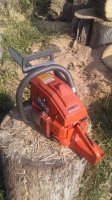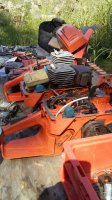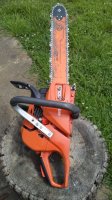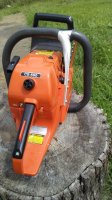The C3M and Walbro HD series are designed to be a certain size. There are limits to what you can do within those size constraints. The Zama took the approach of a good metering carb with the flowed venturi.
Long story, I spent a day with Jerry Branch of Flometrics in Signal Hill back in the early 1970s. Look him up on the 'net - he was the man you went to for porting. I found out he had built a Kawasaki rotary valve engine and I was running one in my desert bike. I called him up and he invited me over "I've got to mail out some heads in the morning, but I have the rest of the day free, anytime after 10am" - I was there at 10.
After we finished discussing the bike (he showed me a trick that I used, it made the carb flow like a bigger carb) we then spent the rest of the day talking flow bench and porting. There was this one head he was proud of and pulled down a stock head off the rack. I looked down the port and thought it looked fine, nice and straight and big with no restrictions. Then he pulled down his ported head - the port was not only smaller it was no longer straight. He kept meticulous records/graphs and showed me the flow rates between the two ports. The smaller port was flowing a lot more than the stock port. - The flow bench doesn't lie!
When I saw the Zama venturi I was reminded of something he showed me about valve guides in ports. Some guys will knock out the valve guide, then grind the port nice and big and then punch the guide back in (think of the carburetor main discharge nozzle sticking out into the carb flow). Jerry explained the turbulence at the base of the guide and how the eddies are parts of the flow that are going BACKWARDS in the port.
He used a lot of modeling clay in his development work on the flow bench. On some heads, to duplicate what the modeling clay told him, he actually welded in extra material around where the valve guide came in so he could port it the shape of the clay.
The Zama has a weird shaped venturi, not only around the base of the nozzle, but also just down stream of the nozzle. It looked like something Jerry Branch would come up with.
One of his best demonstrations came when he put a really slick looking air horn on the flow bench and ran it up. I forget the actual numbers, but say it showed 600 cubic feet a minute. He then took some of his modeling clay and rolled up a little ball about the size of a pea and stuck it on the edge of the air horn. The flow meter jumped up 25 cfm. He then made another 'pea' and put it on the other side of the air horn, up another 25cfm. He eventually had 6 of these ugly clay peas sitting on the edge of the beautiful air horn and the flow bench showed 750 cfm.
I said "so the air horn doesn't work, it restricts the flow". No, he said the carburetor it fits only flowed 450 cfm. So, the air horn is worthless I replied. No, he said, "it makes the owner feel better about his bike" and he laughed.
It was a great day with a true master of the art of porting.












